A Guide to Swimlane Activity Diagrams
Introduction
In today’s dynamic and interconnected business landscape, efficient and effective processes are the lifeblood of organizational success. Yet, as businesses grow and evolve, their processes often become increasingly complex, involving multiple departments, teams, and individuals. It is in this intricate web of activities that Swimlane Activity Diagrams emerge as indispensable tools for clarity, collaboration, and optimization. In this guide, we will explore the world of Swimlane Activity Diagrams, shedding light on their purpose, construction, and when and how to utilize them. Whether you’re a seasoned process analyst or a newcomer seeking to streamline your workflows, this guide will equip you with the knowledge and insights to navigate the labyrinth of business processes with confidence.
What is a Swimlane Activity Diagram?
A Swimlane Activity Diagram, also known as a Swimlane Diagram or Cross-Functional Flowchart, is a visual representation used in business process modeling to depict the steps and interactions within a process involving multiple parties or departments. It divides the diagram into “swimlanes,” which represent different entities, roles, or departments involved in the process. Swimlane diagrams help clarify responsibilities and interactions within a complex workflow.
Here’s how a Swimlane Activity Diagram typically looks:
- Horizontal / vertical lanes: These represent different participants or departments involved in the process. Each lane is responsible for specific activities.
- Activities: These are the tasks or actions that need to be performed within the process. They are represented as rectangular boxes and are placed within the appropriate swimlane to show which participant or department is responsible for each activity.
- Arrows/lines: These indicate the flow of the process, showing how activities are connected and the order in which they occur. Decision points and conditions can also be represented with arrows.

Vertical and Horizonal Swimlane

When to use a Swimlane Activity Diagram:
- Complex Processes: Use swimlane diagrams when you need to map out complex processes involving multiple participants or departments. It helps ensure everyone understands their roles and responsibilities.
- Cross-functional Collaboration: Whenever a process involves collaboration between different teams or individuals, swimlane diagrams are useful for visualizing the handoffs and dependencies.
- Process Improvement: When you want to identify bottlenecks, inefficiencies, or areas for improvement in a process, a swimlane diagram can highlight areas where tasks are getting stuck or taking too long.
- Documentation: Swimlane diagrams serve as valuable documentation for existing processes. They make it easier for new employees to understand how things work.
- Communication: These diagrams are excellent for facilitating communication and discussion among team members or stakeholders involved in the process.
Examples of when to use a Swimlane Activity Diagram:
- Order Processing: A company may use a swimlane diagram to illustrate the steps involved in processing a customer order, with different lanes for sales, inventory, shipping, and finance.
- Software Development: In software development, a swimlane diagram can show the stages and responsibilities of different teams, such as development, quality assurance, and product management.
- Patient Care in Healthcare: Hospitals can use swimlane diagrams to map out the patient care process, including the roles of doctors, nurses, and administrative staff.
- Supply Chain Management: For a manufacturing company, a swimlane diagram can help visualize the various stages of the supply chain, from procurement to production to distribution.
- Customer Support: A swimlane diagram can illustrate how customer support requests are handled, with lanes for different support teams, escalation points, and customer interactions.
Swimlane Activity Diagrams are valuable tools for modeling, understanding, and optimizing complex processes involving multiple participants or departments. They are particularly useful when clarity and collaboration are essential in your organization’s workflows.
Summary
Swimlane Activity Diagrams, also known as Cross-Functional Flowcharts, are visual representations that help organizations map out and understand complex processes involving various departments, roles, and responsibilities. This guide delves into the key concepts of Swimlane Diagrams, offering insights on their application and benefits. We explore situations where Swimlane Diagrams prove invaluable, such as order processing, software development, healthcare, supply chain management, and customer support. Whether you’re looking to document existing processes, identify bottlenecks, or enhance cross-functional collaboration, Swimlane Activity Diagrams serve as powerful tools in your arsenal. By the end of this guide, you will have the knowledge and confidence to use Swimlane Activity Diagrams effectively, bringing clarity and efficiency to your organization’s workflows.

